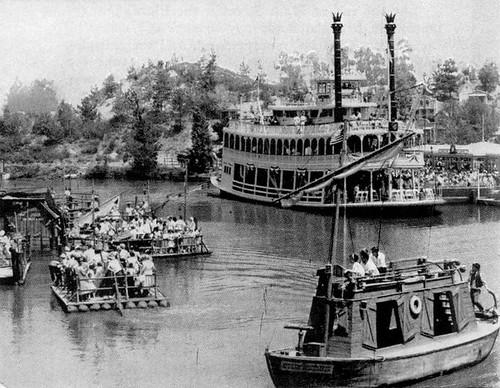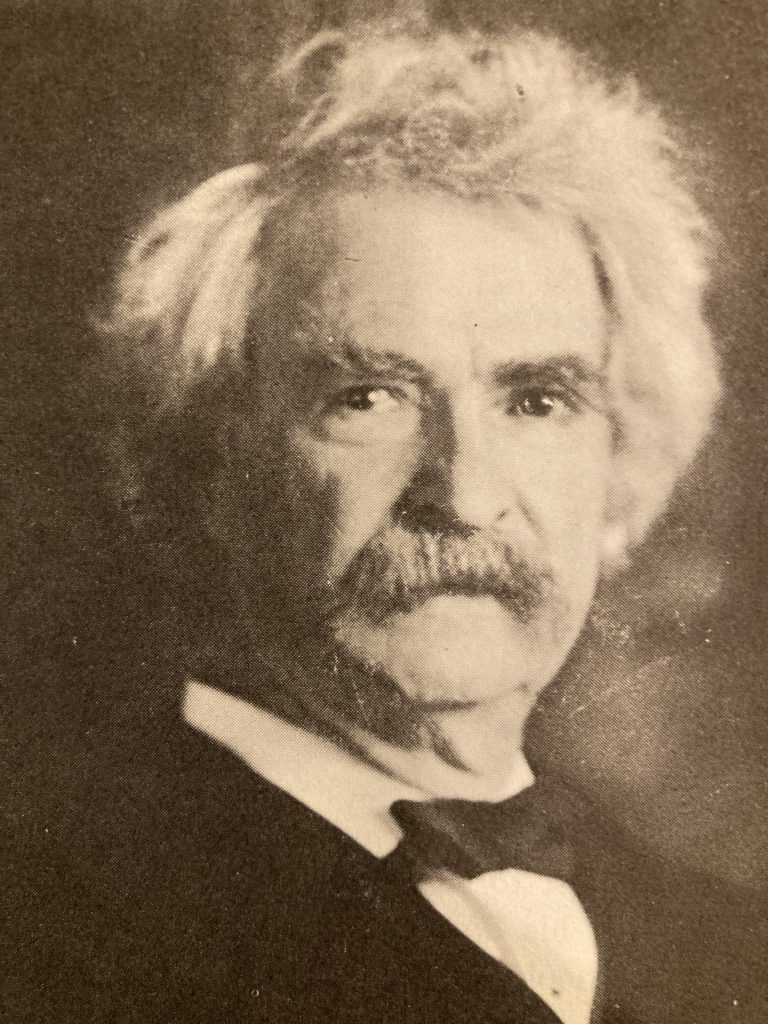“When I was a boy, there was but one permanent ambition among my comrades…that was to be a steamboat man.” Mark Twain.
Many of us think only of Mark Twain as the writer of Tom Sawyer and Huckleberry Finn, but Twain led an adventurous life as a steamboat captain on the Mississippi River, as a miner in the gold fields, writer, printer, essayist, lecturer, world traveler, and humorist. His real name was Samuel Langhorne Clemens. He spent his youth on the Missouri River in the town of Hannibal which provided the materials for much of his early writing.

His father passed on early, so the ambitious Twain haunted the riverfront docks becoming enamored by the steam paddle wheelers plying the river, ferrying passengers, cotton, lumber, furs, foodstuffs and goods needed by settlers moving west during the California Gold Rush days. When you read Tom Sawyer and Huckleberry Finn, you get a true sense of growing up in a river town. The shoreline was filled with small sailboats, large rafts steered with huge oars carrying tonnage, and then there were the huge steamboats, those beautiful paddle wheelers plying up and down large rivers such as the Missouri, Ohio, Mississippi, and Miami. It was natural that he would become a steamboat captain. That’s how he adopted the name, “Mark Twain” which the crew called out to the captain when measuring the depth of the river with a lead weight and a cord. The term “Twain” means two fathoms of depth or twelve feet deep which was safe for a paddle wheeler.

The first steamboat paddle wheeler to navigate the rivers was captained by John Smith in 1819. It took an earth-shattering speed of four days to go from St. Louis to Franklin, Missouri, considered fast in those days, Frankly, I would have jumped overboard and swam. Production of steamboats and captains couldn’t keep up with demand, so Twain was in the position to write his own ticket. He became a riverboat “Cub”, as a trainee was called, in 1857. His master teacher, a grizzled captain named Horace Bixby, taught him the ‘ins and outs’ of river piloting.
Consider the difficulties of being a riverboat captain. During spring the big rivers flooded from heavy rains changing every sandbar and navigable channel. Depths had to be constantly monitored. Captain Twain had to be on a constant lookout for giant floating trees that could stave and sink even a large paddle-wheeler. The Mississippi, Missouri, Miami, Ohio, and connecting deep feeder rivers contain hundreds of sunken steamboat hulls. Then there was the danger of fire from the steam furnaces below and lit cinders flying from the smokestacks, which took down many a boat.
Mark Twain got his full license in 1859 and began piloting the paddle wheel steamboat Alonzo Child traveling upriver from New Orleans. This was the deep South of Anti-Bellum plantations and fields of cotton, worked by slaves. Cotton bales would be transported by steamships to seaports for shipment to England. Those years were called the “Genteel” days of the South. Hardly! It was an era of brutal slavery. The “Civil War” brought his steamboat captain career to an end. The Union took control of all major rivers for military reasons and he was out of a job so the newly unemployed captain joined the Confederate army as a lieutenant. After marching in the rain for two months he itched to move on. Never a supporter of slavery, he high-tailed it to Nevada to make a fortune in mining, which he never did. His time out west inspired a later comedic book titled “Roughing It” but first he had to make a living. His older brother was a newspaperman so it was natural to become a journalist for the Virginia City Enterprise. That’s where he cut his teeth writing. Yet the rivers he grew up on and his time as a captain stayed with him to be immortalized in “Tom Sawyer, Huckleberry Finn” and his 1883 masterpiece “Life on the Mississippi” about the early years of paddle wheelers, you’ll feel your part of river life if you read it.
After the war, he found himself in San Francisco as a reporter for the newspaper “Alta Californian”. The publisher knew of Twain’s career as a captain and offered him assignments he couldn’t turn down. In 1866 he was invited to go on the maiden voyage of the Ajax and spend months reporting on the beauty, foreign relations, and new Yankee settlements in the Sandwich Islands (Hawaii).
Upon returning to San Francisco, now rich with high society and a port bristling with ship masts, the publisher asked him to take a European and Mid-East cruise with a group of high society folks from all over the United States, to visit all the major cities and archeological sites from the Pyramids of Egypt, the canals of Venice, St. Peters Cathedral, Greek ruins, the Holly Land, Istanbul, all the Black Sea ports and send back articles. “Yes,’’ he said, with his captain’s smile. Once you’ve had a taste of rivers and oceans, it never leaves you! Twain first sailed from San Francisco, crossed Panama on land, and then sailed to New York where he spent a good amount of time becoming acquainted with the politics and society of both the rich and the politicians he would skewer in his correspondent reports. Then Twain boarded the Quaker City and spent a full four months sailing the seas.
Out of this journey came another masterpiece “Innocents Abroad, or a Pilgrims Progress”. What this book or travelogue does, is skewer all the two-faced, un-Christian-like, greedy, thieving, and generally unpleasant wealthy fellow passengers. (Nothing ever changes, does it?) Twain knew how to read people, especially since they all spent much time in the confines of the ship. He held nothing back. Even the captain, Charles C. Duncan, cannot escape his critical pen. He notes how the ship handled, the furious storms, and the calm days at sea. Ten years after the voyage, the captain and Twain were still engaged in acid correspondence. It seems as if the two captains disagreed on how to handle a vessel and crew.
Twain describes his cabin mate, Dan Slote, as “Immoral, tobacco smoking, wine drinking, Godless” and there were “no words strong enough to damn the man!’’ (I find that an apt description of myself, only I don’t smoke!) There was the detestable, horse laughing, Mr. Greer, and Dr. Andrews, the know-it-all all. On and on he goes disassembling hypocrisy, but he does cut the ladies some slack. This book is still published 150 years later.
Twain made many other sea-faring trips over his life, in 1891 he and his family sailed to Europe where he served as a roving ambassador amongst the ruling families. He lived there for several years, sending his observations and criticisms of life in Europe to be published in the United States and his wit made him the most popular American writer.
Twain wrote 28 books in his life, an untold number of essays, newspaper reports, gave innumerable speeches. He was a life force
Every one of his books is worth reading today. They still hold their sense of humor, especially those of nautical historical value. It’s well worth it when you’re sweltering in your own boat cabin and need something to occupy your mind. I don’t have to because I lost my mind years ago
One parting note, the day Mark Twain was born on November 30th, 1835-Haleys comet streaked across the sky. He always said he “Came in on a comet and would ride out on one” – He died on the night Haley’s comet returned on April 22nd, 1910. Mark Twain/ Samuel Clemens
A Steamboat Cap for the ages!
Copyright 2024 by Mark C. Nuccio All rights reserved
You can reach Mark -mark@designedge.net
